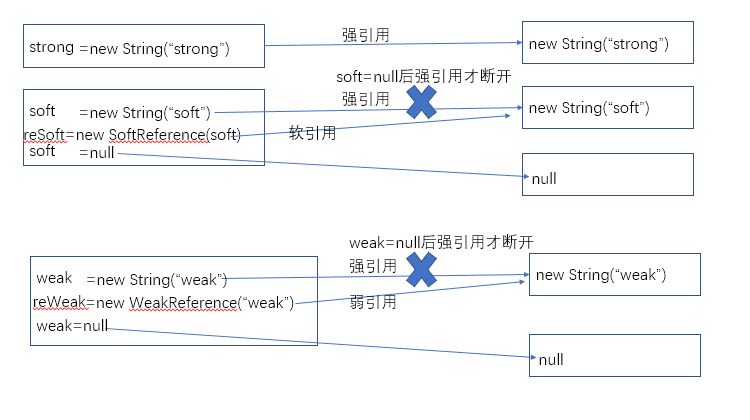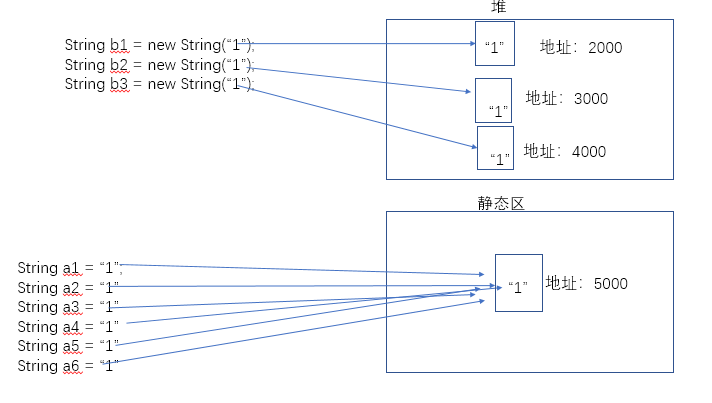一、引用分类
强:运行垃圾回收机制后也不回收,程序出现内存溢出也不回收。
软:在垃圾回收机制运行时判断内存是否已满,如果内存已满则回收,内存充足则不回收。
弱:垃圾回收机制运行后不论内存是否充足都会立即回收。
虚:虚引用和没有引用一样,必须配合引用队列使用。
我们来看例子:
import java.lang.ref.PhantomReference; import java.lang.ref.Reference; import java.lang.ref.ReferenceQueue; import java.lang.ref.SoftReference; import java.lang.ref.WeakReference; import java.util.HashMap; import java.util.Iterator; import java.util.Map; import java.util.Map.Entry; import java.util.Set; public class Test{ final Map<String,SoftReference> m = new HashMap<>(); public static void main(String args[]){ //创建一个新的弱引用,引用给定的对象 String strong = new String("strong");//strong对"strong"的强引用 String soft = new String("soft");//soft对"soft"的强引用 String weak = new String("weak");//weak对"weak"的强引用 String phantom = new String("phantom");//phantom对"phantom"的强引用 ReferenceQueue<String> queue = new ReferenceQueue<String>();//引用队列 Reference<String> reStrong = new SoftReference<>(strong); Reference<String> reSoft = new SoftReference<>(soft);//reSoft对"soft"的软引用 Reference<String> reWeak = new WeakReference<>(weak);//reWeak对"weak"的弱引用 Reference<String> rePhantom = new PhantomReference<>(phantom,queue);//rePhantom指向"phantom"的虚引用 soft = null;//断开soft对"soft"的强引用 weak = null;//断开weak对"weak"的强引用 phantom = null;//断开phantom对"phantom"的虚引用 //断开强引用后,就只剩下reSoft对"soft"的软引用,reWeak对"weak"的弱引用,rePhantom对"phantom"的虚引用 System.out.println("strong运行gc前:"+strong);//强引用对象 System.out.println("soft运行gc前:"+reSoft.get());//获取当前软引用的对象 System.out.println("weak运行gc前:"+reWeak.get());//获取当前弱引用的对象 System.out.println("phantom运行gc前:"+rePhantom.get());//获取当前虚引用的对象 System.gc();//运行垃圾回收 System.out.println("-----------------------"); System.out.println("strong运行gc后:"+strong);//强引用对象 System.out.println("soft运行gc后:"+reSoft.get());//获取当前软引用的对象 System.out.println("weak运行gc后:"+reWeak.get());//获取当前弱引用的对象 System.out.println("phantom运行gc后:"+rePhantom.get());//获取当前虚引用的对象 } }
运行结果:
strong运行gc前:strong soft运行gc前:soft weak运行gc前:weak phantom运行gc前:null ----------------------- strong运行gc后:strong soft运行gc后:soft weak运行gc后:null phantom运行gc后:null
我们看上述结果:
强引用在运行垃圾回收后也不会被回收,软引用在运行垃圾回收后,如果内存足够则不回收,如果内存不足则回收。
弱引用在运行垃圾回收后,不论内存是否充足都会对其回收。虚引用就可没有引用一样,无论何时都会被回收。
一般像Date time = new Date();这种都是强引用,也是我们平常使用最多的,只要强引用存在,gc运行后不会对其回收。
我们先看上列代码中的软引用所引用,一开始soft对象对“soft”是一个强引用,然后reSoft对“soft”是一个软引用,
之后soft对象指向null,即断开了对“soft”的强引用,此时只剩下reSoft对“soft”的软引用。
再来分析弱引用,一开始weak对“weak”的强引用,然后是reWeak对“weak”的一个弱引用,
之后weak对象指向nul,即断开了对“weak”的强引用,此时只剩下reWeak对“weak”的弱引用。
最后后还有一个虚引用phantom。
下面画个图来看下:

还有一点需要说明:
我们先来看下列代码:
import java.lang.ref.PhantomReference; import java.lang.ref.Reference; import java.lang.ref.ReferenceQueue; import java.lang.ref.SoftReference; import java.lang.ref.WeakReference; import java.util.HashMap; import java.util.Iterator; import java.util.Map; import java.util.Map.Entry; import java.util.Set; public class Test{ final Map<String,SoftReference> m = new HashMap<>(); public static void main(String args[]){ String weak = "weak";//weak对"weak"的强引用 Reference<String> reWeak = new WeakReference<>(weak);//reWeak对"weak"的弱引用 weak = null;//断开weak对"weak"的强引用 System.out.println("weak运行gc前:"+reWeak.get());//获取当前弱引用的对象 System.gc();//运行垃圾回收 System.out.println("-----------------------"); System.out.println("weak运行gc后:"+reWeak.get());//获取当前弱引用的对象 } }
运行结果: weak运行gc前:weak ----------------------- weak运行gc后:weak
看到这个可能会有疑问,不是只有一个弱引用执行"weak"吗,运行gc后应该会被回收呀?
大家注意new String("weak")和“weak”是不一样的,前者新建一个对象时是放在堆中,而后者是一个字符串常量是放在静态区的。
而静态区的对象是不会被清理的,所以即使只有弱引用指向“weak”,但由于“weak”不会被清理,所以弱引用依然指向"weak"。
对于需要经常使用的内容我们可以采用软引用,这样在需要使用时既不会被回收,也不会出现内存溢出(OOM)错误,很适合做为缓存。
当一些只需要少量使用较大数据时,我们可以采用弱引用,防止其占用内存。
这些可以根据具体使用情况优化引用关系。
这里有一个别人举得使用软引用优化内存溢出的例子:
例子出自:https://blog.csdn.net/arui319/article/details
//首先定义一个HashMap,保存软引用对象。
private Map<String, SoftReference<Bitmap>> imageCache = new HashMap<String, SoftReference<Bitmap>>(); public void addBitmapToCache(String path) { // 强引用的Bitmap对象 Bitmap bitmap = BitmapFactory.decodeFile(path);//此方法被执行完,bitmap会被清理,此时只保留下了imageCache中对 // 软引用的Bitmap对象 //BitmapFactory.decodeFile(path)的软引用,要是实在不放心就对bitmap置null. SoftReference<Bitmap> softBitmap = new SoftReference<Bitmap>(bitmap); // 将软引用对象放到到Map中使其缓存 imageCache.put(path, softBitmap); } public Bitmap getBitmapByPath(String path) { // 从Map中取软引用的value(Bitmap)对象 SoftReference<Bitmap> softBitmap = imageCache.get(path); // 判断当前软引用对象是否被清理 if (softBitmap == null) { return null; } // 如果被清理返回null,反之返回改对象 Bitmap bitmap = softBitmap.get(); return bitmap; }
二.WeakHashMap
理解了上列内容,就很容易理解WeakHashMap了。
WeakHashMap的键是弱引用,回收键后删除key-value对象。
import java.util.Iterator; import java.util.Map; import java.util.Set; import java.util.WeakHashMap; public class TestWeakHashMap { public static void main(String[] args) { // TODO Auto-generated method stub Map<String ,String> m = new WeakHashMap<>(); m.put(new String("1"), "一"); m.put(new String("2"), new String("二")); m.put("3", new String("三")); m.put(new String("4"), new String("四")); System.gc(); Set<Map.Entry<String,String>> s_m = m.entrySet(); Iterator<Map.Entry<String,String>>ite = s_m.iterator(); while(ite.hasNext()){ Map.Entry<String, String> en = ite.next(); System.out.println("ket:" + en.getKey() + " " + "value:" + en.getValue()); } } }
运行结果:
ket:3 value:三
运行gc后弱引用的键都被回收了,但“3”在静态区不会被回收,所以弱引用仍然可以指向“三”。
三、IdentityHashMap
IdentityHashMap是比较键的地址去重,如果键的地址相同就代表同一个对象,如果键的地址不同就表示不同对象。
而HashMap是使用hashCode和equals去重。
import java.util.IdentityHashMap; import java.util.Map; public class TestIdentityHashMap { public static void main(String[] args) { // TODO Auto-generated method stub Map<String,String> m = new IdentityHashMap<>(); m.put("1", "1");//保留 m.put("1", "1");//覆盖前一个的value "1" m.put(new String("1"), "1");//保留 m.put(new String("1"), "1");//保留 System.out.println(m.size()); } }
运行结果:
3
第一个“1”是字符串常量,存放在静态区是共享的,第一个和第二个“1”都是指向同一个存放在静态区的常量“1”。所以第二个放置时地址相同会替换旧值。
new String("1"),是在堆中开辟一块存放“1”的地址,无论该值是否存在,只要new了就会开辟一个新的空间。
我们来看一个图:

四.EnumMap
键(key)必须为枚举的值,构造方法中必须为指定枚举类。
import java.util.EnumMap; import java.util.Iterator; import java.util.Map; import java.util.Map.Entry; import java.util.Set; public class TestEnumMap { public static void main(String args[]){ Map<Season,String> m = new EnumMap<>(Season.class);//构造方法指定枚举类 m.put(Season.SPRING, "春困"); m.put(Season.SUMMER, "夏乏"); m.put(Season.AUTUMN, "秋无力"); m.put(Season.WINTER, "冬日正好眠"); Set<Entry<Season, String>> s_m = m.entrySet(); Iterator<Entry<Season, String>>ite = s_m.iterator(); while(ite.hasNext()){ Entry<Season, String> en = ite.next(); System.out.println(en.getValue()); } } } enum Season{ SPRING,SUMMER,AUTUMN,WINTER }
运行结果:
春困
夏乏
秋无力
冬日正好眠